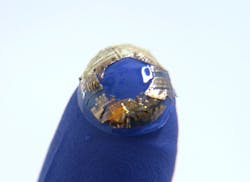Smart Contact Lenses Correct for Vision, Monitor Health
Purdue University researchers have developed soft contact lenses that not only correct vision, but also monitor glucose and medical conditions, in addition to providing ocular pain relief or drug delivery.
For a long time, sensors and other technologies couldn’t be mounted on soft contact lenses because they required a rigid, planar surface incompatible with the soft, curved shape of a contact lens. But the Purdue team created a novel mounting method for attaching sensors and other small devices to soft contact lenses.
“We developed a unique technology that combines thin-film sensors with commercially available soft contact lens,” says Chi Hwan Lee, an assistant professor of biomedical engineering and mechanical engineering at Purdue and the leader of the team. “These current hydrogel-based contacts serve as the perfect platform for smart lens systems due to their high degree of comfortability, biocompatibility, breathability, and long-term wearability. Before our discovery, it was challenging to fabricate high-performance electronics on commercially available soft contact lenses.”
The sensors embedded on the soft contact lens continuously detect glucose and lactate levels of glucose, along with pH values, providing information associated with diabetes, hypoxia, and underlying ocular tissue health. With the ability to combine soft, silicon-based contact lenses with a variety of different semiconductor devices, numerous advanced eye care applications are now possible.
“This technology is highly novel and will significantly expand the functions that can be put on soft contact lenses,” Lee says. “This technology will also form a basis to further extend the functions of smart contact lens system for many other applications, including controlled release of ocular drugs, night vision, and augmented reality.”
Lee’s team is continuing to test the mechanical and electrical properties of the lens technology. The Purdue Office of Technology Commercialization helped secure a patent for the technology, and it is available for licensing.

